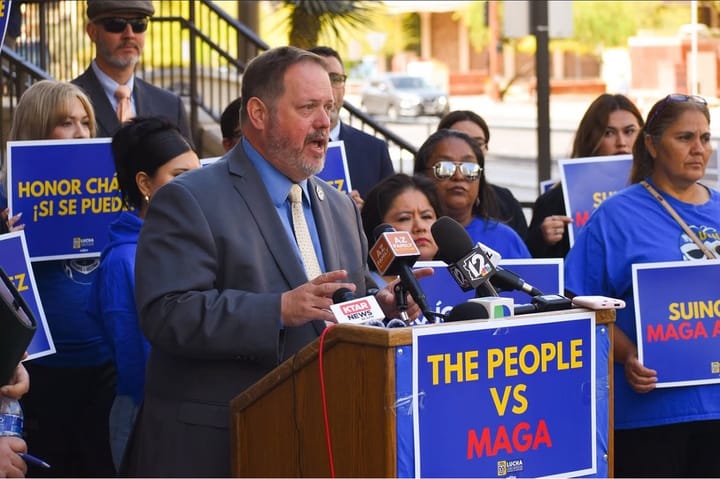Tucson, Pima County officials break down recent climate initiatives
With rising temperatures, dwindling water supplies, and increasing carbon emissions, Pima County and Tucson have stepped up with innovative solutions to these pressing challenges, all while prioritizing sustainability for residents.

In what feels like an endless summer, Tucsonans were treated to another 100-degree day just over a week away from the start of November.
This fall, Tucson set the city’s latest-ever date hitting temperatures greater than 105 degrees, and tied or broke daily heat records on 19 out of 20 days from late September through the middle of October.
Year after year, Tucson continues to see heat records fall, so it’s no surprise that local officials decided a few years ago to declare a climate emergency.
With rising temperatures, dwindling water supplies, and increasing carbon emissions, Pima County and Tucson have stepped up with innovative solutions to these pressing challenges, all while prioritizing sustainability for residents.
Since becoming the first county in Arizona to adopt a Sustainable Action Plan with measurable goals and concrete actions in 2007, Pima County and the City of Tucson have made great strides in advancing sustainability practices, Mayor Regina Romero said during Tuesday’s City Council meeting.
“The Tucson Resilient Together plan was created in record time, unlike any other city in the country,” she said of the city’s Climate Action Plan, which was adopted in May. “Usually, cities take three to four years. We did it in 14 months with plenty of community engagement.”
The city and county face significant environmental hurdles, but officials have responded by establishing measurable targets and implementing three key climate resolutions, including Pima County’s noteworthy Climate Resolution, The resolution details Pima County’s commitment to cutting carbon emissions and enhancing its resilience to climate change.
To combat the record-breaking summer heat, the City of Tucson rolled out the Heat Action Roadmap in May. The roadmap prioritizes equitable approaches to address heat-related issues, ensuring that the needs of vulnerable communities are met, with several city departments quickly springing into action.
“We distributed over 900 heat relief kits across the community (this summer), mainly to the unhoused, but also in some mobile home parks,” said Chief Resilience Officer Fatima Luna. “We learned a lot this summer, so we're going to take those lessons and improve our heat response and preparedness strategy for next summer.”
In addition to spearheading local efforts to address extreme heat, Pima and Tucson officials are also seeking to help other municipalities do the same.
In February, the City of Tucson co-hosted the Heat Planning Summit in collaboration with the University of Arizona and the Pima County Health Department, bringing together over 110 experts to develop responses to extreme heat.
A survey showed that residents are most concerned about drought, excessive heat, and water accessibility.
“There was a cumulative average of over 35 days, equivalent to an extra month, of temperatures exceeding 100 degrees,” Sara Davis, an environmental quality advisor with the county, said during a supervisors meeting earlier this month. “This trend shows a consistent annual increase in extreme heat days.”
While the increase in extreme temperatures is concerning, it’s not all bad news.
Pima County has been able to exceed its carbon reduction goals, positioning itself to meet its 2030 target. Collaborating with regional partners, Tucson and Pima County are also focusing on reducing emissions through innovative methods.
“The county's two biggest (departmental) sources of carbon emissions come from wastewater and facilities. Both have ongoing projects with upgraded equipment, which has significantly reduced energy use and overall carbon emissions,” said Director of Environmental Quality Scott DiBiase. “As a result, we've not only met our … 2025 goal, but surpassed it a year ahead of schedule.”
DiBiase said that together, these initiatives aim to reduce the region's carbon emissions by about 1.5 million metric tons.
One less-publicized feature of the climate action plan is the role of solar energy, an omission that Supervisor Sylvia Lee mentioned during the presentation.
"We have an ongoing effort to enhance our solar capabilities, which has significantly contributed to the carbon emission reductions shown in our graphs,” DiBiase said. “This is part of a dedicated initiative by the county to not only lower our emissions but also reduce electricity usage, ultimately benefiting our overall budget."
As water scarcity grows, Pima County is employing innovative methods to reduce water demand and improve collection.
“We have also reactivated the water working group, which will establish its new priorities specifically addressing scarcity and degradation, looking at innovative ways to use water harvesting and alternate uses of water,” said county Environmental Quality Advisor Davis.
At the same time, the threat of wildfires from invasive species such as stinknet and buffelgrass is being addressed with a three-year grant from the U.S. Forest Service and Arizona Department of Forestry.
Securing grants has been a high priority for creating a healthy environment for people and wildlife. Tucson’s Urban Forestry Program has planted over 120,000 trees since 2020, supported by a $5 million Grow Tucson grant from the USDA Forest Service.
In addition, Tucson secured $16.1 million to enhance bus stops and upgrade aging infrastructure, decrease turf and asphalt areas, expand green stormwater infrastructure, tree coverage, and much more.
The city is also exploring renewable energy options through the Energy Sourcing Study with GDS Associates, aiming to position itself as a national leader in climate action.
Angelina Maynes is a journalism major at the University of Arizona and reporter with Tucson Spotlight. Contact her at angelinamaynes@arizona.edu.




